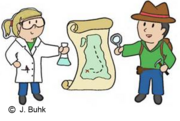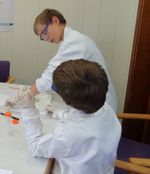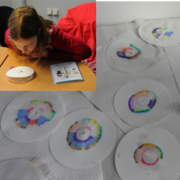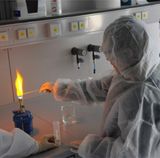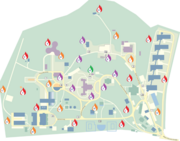Huge Success - Geochemical Treasure Hunt for Primary School Children
How can you inspire school children about geochemistry and scientific investigations? The key is simply, make learning fun and raise their curiosity. The Fellows of the European Marie Curie Initial Training Network IsoNose designed a “Geochemical Treasure Hunt” to excite children for scientific investigations. This hands on workshop explains primary school children the research and scientific methods of isotopic geochemistry and their application. By performing various experiments, they will gather information leading them to the location of a hidden treasure.
On 23rd November 2016 a school class from Potsdam visited the GFZ German Research Centre for Geosciences to participate in the treasure hunt. Before starting their scientific investigations, the school children learned hands on the meaning of elements, atoms and isotopes. Then, of course, a security briefing was needed. Here they learned “not to run, eat or play in the lab”, as one girl put it. Moreover, they also had to wear protective clothing (gloves, goggles, lab coat), which was received enthusiastically by the children and helped them to settle like real scientists.
In teams of two to three kids they conducted experiments of simplified methods being indispensable to any isotope geochemist. Emphasis was placed on all aspects, so the children also recorded their observations and results accurately into their lab journals. For sample preparation the groups got mineral samples, which they weighed, grinded and dissolved in citric acid. Then the separation of elements before isotopic analysis was visualised, using colour chromatography. After telling the children that most colours actually consisted out of several other colours (to which they reacted in disbelief), they started making colourful patterns, using felt pens on filter paper and dipping the filter paper into water. A few minutes later they observed with amazement that it was true, each colour revealed other colours and the darker ones turned out to reveal the most colourful pattern. “The impossible is sometimes possible” uttered one of the boys his astonishment.
In one of the laboratory the IsoNose Fellow Daniel Frick explained high-tech equipment for geochemical analyses. Instead of using these very delicate instruments, the pupils applied the flame colour spectroscopy to analyse their dissolved mineral solutions. In the course of this, they observed, that holding their solutions into a flame will cause a change in colour that is related to the specific element present: red for Lithium, violet for Potassium, green-yellow for Barium and orange for Calcium.
Finally, the children plotted the results of the flame spectroscopy onto a map and by interpreting the emerging colour patterns, localized the treasure on the map. In teams of six children – all buzzing with excitement – they swarmed out on the GFZs’ premises. All groups were excellent hunters and succeeded in uncovering the hidden treasure. This was very exciting, still most kids thought the experiments were the most memorable events of the day or concluded “My favourite thing was everything”.
Acknowledgements
The GFZ GeoWunderWerkstatt and the Section 3.3 Earth Surface Geochemistry, led by Friedhelm von Blanckenburg, strongly support the IsoNose team in the implementation of each “Geochemical Treasure Hunt”, taking place biannually.
- For booking a school workshop please contact the GFZ GeoWunderWerkstatt
- For further information on the experiments of the “Geochemical Treasure Hunt" please contact the authors Ruben Gerrits and Maja Tesmer
- For further information on IsoNose visit the other IsoNose websites


